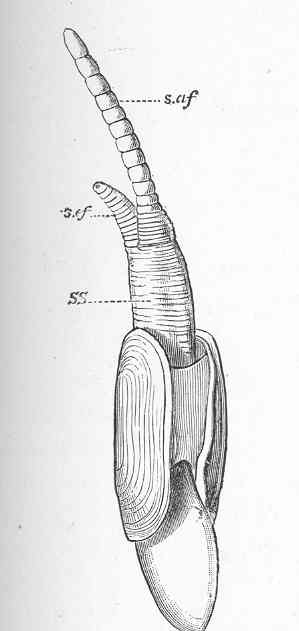Rosy Razor Clam on:
[Wikipedia]
[Google]
[Amazon]
''Solecurtus strigilatus'', also known as the rosy razor clam, is a species of saltwater
 The species lives immersed in soft sediment, usually medium-grade sand. The burrow is "J"-shaped and has a
The species lives immersed in soft sediment, usually medium-grade sand. The burrow is "J"-shaped and has a
clam
Clam is a common name for several kinds of bivalve molluscs. The word is often applied only to those that are edible and live as infauna, spending most of their lives halfway buried in the sand of the seafloor or riverbeds. Clams have two shel ...
, a marine bivalve mollusc in the family Solecurtidae
The Solecurtidae are a family of saltwater clams, marine bivalve molluscs in the order Cardiida.
Genera
Genera in the family Solenidae include:
* '' Azorinus'' Récluz, 1869
* '' Clunaculum'' Dall, 1899
* ''Solecurtus'' Blainville, 1824
* ''Tage ...
. This mollusc is a suspension feeder and can burrow with great rapidity to escape predators. It is an unusual bivalve in that its shell valves are too small to contain all the soft tissue, and the animal is unable to retreat into its shell.
Description
The valves of the rosy razor clam are relatively small, thin and finely sculptured. At the anterior end of the animal there is a strong, protruding foot. At the posterior end, is the large mantle sac containing the gills; when relaxed, it protrudes and is twice the length of the valves, but it can be contracted back between the valves. Posterior to this are the two robust, contractile siphons. The maximum length of the shell is .Distribution
The rosy razor clam occurs in the Mediterranean Sea and the adjoining part of the Atlantic Ocean. It is present from the lower shore down to the shallow sublittoral zone.Behaviour and ecology
 The species lives immersed in soft sediment, usually medium-grade sand. The burrow is "J"-shaped and has a
The species lives immersed in soft sediment, usually medium-grade sand. The burrow is "J"-shaped and has a mucus
Mucus ( ) is a slippery aqueous secretion produced by, and covering, mucous membranes. It is typically produced from cells found in mucous glands, although it may also originate from mixed glands, which contain both serous and mucous cells. It ...
lining. The clam has two siphons which it can extend to the surface in order to feed, but when not feeding it burrows further into the sediment, often living under the sand surface. Many clams are detritivores, consuming decomposing organic matter they find in their environment, but this clam is a filter feeder, drawing water in through one siphon, removing the edible particles and exhaling the water through the other siphon. It can dig through the sand with great rapidity, and any attempt by humans to dig it out results in it descending diagonally, even deeper into the sediment. In an apparent attempt to distract predators, the tips of the two siphons can be shed, and these pulsate as they drift in the water column. The ends of the siphons can be regenerated. The presence of this clam in the sediment is evidenced by two circular holes each wide and apart, through which the siphons can be projected.
Digging is a five-phase process; the mantle sac and siphons fill with water and the foot remains contracted; the siphons close, forcing water into the mantle sac while the foot unfolds; the mantle sac contracts, directing a jet of water in front of the foot; the foot is pushed into the loosened sediment; the tip of the foot expands to provide an anchor and the body is drawn down, ready to start the next cycle.
References
{{Taxonbar, from=Q14363598 Solecurtidae Molluscs described in 1758 Molluscs of the Atlantic Ocean Molluscs of the Mediterranean Sea Taxa named by Carl Linnaeus